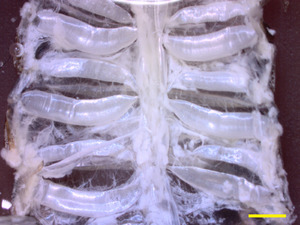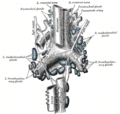Trachea facts for kids
The trachea, also known as the windpipe, is a tube that helps you breathe. It connects your nose and mouth to your lungs. It's a very important part of your respiratory system, which is the system your body uses to take in oxygen and let out carbon dioxide. The trachea starts below your voice box (the larynx) and goes down to your lungs. There, it splits into two smaller tubes called bronchi, one for each lung. If the lining of your trachea gets swollen or irritated, it's called tracheitis.
Your Amazing Windpipe
Your trachea is a tube about 10 to 12 centimeters (4 to 5 inches) long. It's made of strong, flexible rings of cartilage. These rings keep the windpipe open so air can always pass through easily. Imagine a vacuum cleaner hose – it has rings to keep it from collapsing! Your trachea works in a similar way.
Inside your trachea, there are tiny hairs called cilia. These cilia are always moving, sweeping out dust, germs, and other tiny particles that might get into your airways. They work like a tiny cleaning crew, pushing unwanted stuff up towards your throat so you can cough it out or swallow it. This helps keep your lungs clean and healthy.
How Insects Breathe

Did you know that insects and other arthropods, like spiders, also have a kind of trachea? It's very different from ours! Their breathing system is called an invertebrate trachea. It's an open system that helps them get gases like oxygen to their body parts and remove carbon dioxide.
Insects don't have lungs like humans. Instead, they have tiny holes on the sides of their bodies called spiracles. These spiracles are like little doors that open and close to let air in and out. Each spiracle connects to a network of tubes called tracheae.
These tracheae branch out into even smaller tubes called tracheoles. These tiny tracheoles reach almost every cell in the insect's body! Oxygen from the air travels directly through these tubes to the cells, and carbon dioxide travels back out. This is different from humans, where oxygen is carried by blood. Because insects don't use blood to carry oxygen, this is one reason why they can't grow as big as many other animals.
Some insects, like grasshoppers and bees, can even pump air through their bodies using special air sacs. This helps them get more oxygen when they are very active. Even though these tubes are inside the insect, they are shed and regrown when the insect sheds its outer skin (a process called molting).
Images for kids
-
The tiny tubes of the tracheal system reaching the crop (a part of the digestive system) of a cockroach.
See also
 In Spanish: Tráquea para niños
In Spanish: Tráquea para niños








